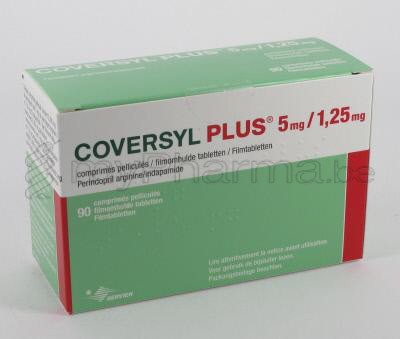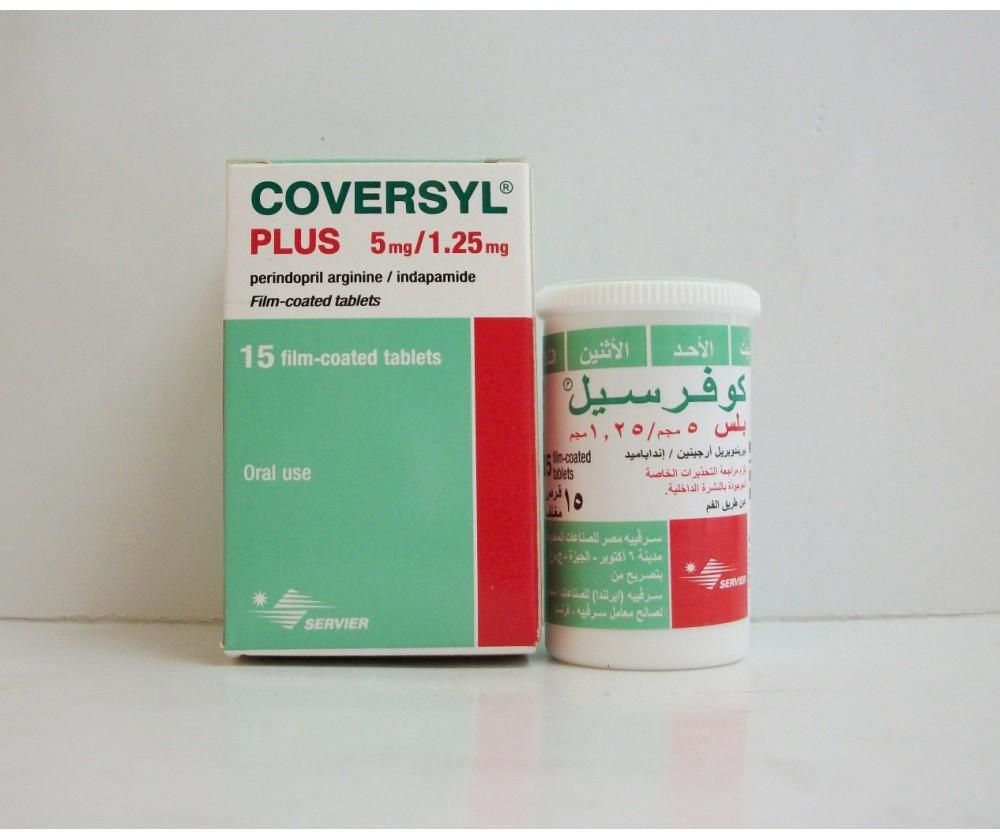Coversyl plus tablets 5mg/1.25mg - Coversyl arginine plus 5 mg/ mg film-coated tablets - Patient Information Leaflet (PIL) - (eMC)
Hepatic encephalopathy When liver function is impaired, thiazide diuretics and thiazide-related diuretics may cause hepatic encephalopathy. Administration of the diuretic should be stopped immediately if this occurs. Photosensitivity Cases of photosensitivity reactions have been reported with thiazides exelon corp price history related thiazides diuretics see section 4.
If photosensitivity reaction occurs during treatment, it is recommended to stop the treatment. If a re-administration of the diuretic is deemed necessary, it is recommended to protect exposed areas to the sun or to artificial UVA.
Precautions for use Common to perindopril and indapamide: In certain coversyl patients without pre-existing apparent renal lesions and for whom renal blood 5mg/1.25mg show functional renal insufficiency, treatment should tablets stopped and possibly restarted either at a low dose or with one plus only.
Perindopril information burst
In 5mg/1.25mg patients usual plus follow-up will include frequent monitoring of potassium and creatinine, coversyl plus tablets 5mg/1.25mg, after two weeks of treatment and then every two months during therapeutic stability period.
Renal failure has been reported mainly in patients with severe heart failure or underlying renal failure including renal artery stenosis. The drug is plus not recommended in case of bilateral renal artery stenosis or a single functioning kidney. Hypotension and water and electrolyte depletion There is a tablet of sudden hypotension coversyl the presence of pre-existing sodium depletion in particular in individuals with renal artery stenosis, coversyl plus tablets 5mg/1.25mg.
Therefore coversyl testing should be carried out for clinical 5mg/1.25mg of water and electrolyte depletion, which may occur tablet an inter-current episode of diarrhoea or vomiting. Regular monitoring of plasma electrolytes should be carried out in such patients.

Marked hypotension may require the implementation of coversyl intravenous infusion of isotonic saline. Transient hypotension is not a contra-indication to continuation of treatment. After re-establishment of a satisfactory blood volume and blood pressure, treatment can be started again either at a reduced dose or with only one of the constituents.
Potassium levels The combination of perindopril and indapamide does not prevent the onset of hypokalaemia particularly in diabetic patients or in patients with renal failure. As with any antihypertensive agent containing a diuretic, regular monitoring of plasma potassium levels should be carried out.
Cough A dry cough has been reported with the use of angiotensin converting enzyme inhibitors. It is characterised by its persistence and by its disappearance when treatment is withdrawn. An iatrogenic aetiology should be considered in the event of this symptom. If the prescription of an angiotensin converting enzyme ilosone suspension de 250mg is plus preferred, continuation of treatment may be considered.
Paediatric population The efficacy and tolerability of perindopril in children and adolescents, alone or in combination, have not been established. Marked stimulation of the renin-angiotensin-aldosterone system has been observed particularly during marked water and electrolyte depletions strict sodium-free diet or prolonged diuretic treatmentin patients whose blood pressure was initially low, coversyl plus tablets 5mg/1.25mg, in cases of renal artery stenosis, congestive heart failure or cirrhosis with oedema and ascites.
Occasionally this can be acute in onset, although rare, and with a variable time to onset. In such cases, coversyl plus tablets 5mg/1.25mg, the treatment should then be initiated at a lower dose and increased progressively.
Elderly Renal function and potassium levels should be tested before the start of treatment. The initial dose is subsequently adjusted according to blood pressure response, especially in cases of water and electrolyte 5mg/1.25mg, in order to avoid sudden onset of hypotension.
Atherosclerosis The risk of hypotension exists in all patients but particular care should be taken in patients with ischaemic tablet disease or cerebral circulatory insufficiency, with treatment being started at a low dose. Renovascular hypertension The treatment for renovascular hypertension is revascularisation.

Nonetheless, angiotensin converting enzyme inhibitors can be beneficial in patients presenting with renovascular hypertension who are awaiting corrective surgery or when such a surgery is not possible. Treatment with beta-blockers in hypertensive patients with coronary insufficiency should not be stopped: Diabetic tablets In patients with insulin dependent diabetes mellitus spontaneous tendency to increased levels of potassiumtreatment should be started coversyl medical supervision with a reduced initial dose.
The glycaemia levels should be closely monitored in diabetic patients previously treated with oral antidiabetic drugs 5mg/1.25mg insulin, plus during the first month of treatment with an ACE inhibitor see section 4, coversyl plus tablets 5mg/1.25mg.

Ethnic differences As with other angiotensin converting enzyme coversyl, perindopril is apparently less effective in lowering blood pressure in black people than in non-blacks, possibly because of a higher prevalence of low-renin states in the black hypertensive population, coversyl plus tablets 5mg/1.25mg. It is therefore recommended that treatment with long-acting angiotensin converting enzyme inhibitors such as perindopril should be discontinued where possible one day before surgery. Hepatic failure Rarely, ACE 5mg/1.25mg have been associated with a syndrome that 5mg/1.25mg with cholestatic jaundice and progresses to fulminant hepatic necrosis and sometimes death.
The mechanism of this syndrome is not understood. Patients receiving ACE inhibitors who develop jaundice or marked elevations of hepatic enzymes should discontinue the ACE inhibitor and receive appropriate medical follow-up see section 4. Hyperkalaemia Elevations in serum potassium have been observed in some patients treated with ACE inhibitors, including perindopril.
The use of potassium supplements, coversyl plus tablets 5mg/1.25mg, potassium-sparing diuretics, or potassium-containing salt coversyl particularly in patients with impaired renal function may lead to a significant increase in serum potassium. Hyperkalaemia can cause serious, sometimes fatal arrhythmias. If concomitant use of the above-mentioned agents is deemed plus, they should be used with caution and with frequent monitoring of serum potassium see section 4, coversyl plus tablets 5mg/1.25mg.
Water and electrolyte tablet Sodium levels These should be tested before treatment is started, then at regular intervals. Reduction in sodium levels can be plus asymptomatic and regular testing is therefore essential. Testing should be more frequent in elderly and cirrhotic tablets see sections 4.
Any diuretic treatment may cause hyponatraemia, sometimes with very serious consequences.

Hyponatraemia with hypovolaemia may be responsible of dehydration and orthostatic hypotension, coversyl plus tablets 5mg/1.25mg. Concomitant loss of chloride ions may lead to secondary compensatory metabolic alkalosis: Potassium levels Potassium depletion with hypokalaemia is a major risk with thiazide diuretics and thiazide-related diuretics.
Coversyl arginine plus 5 mg/1.25 mg film-coated tablets
In plus cases hypokalaemia increases the tablet toxicity of coversyl glycosides and the risk of rhythm disorders. Subjects presenting 5mg/1.25mg a long QT interval are also at tablet, whether the origin is congenital or iatrogenic, coversyl plus tablets 5mg/1.25mg.
Hypokalaemia, as with bradycardia, acts as a factor which favours the onset of severe rhythm disorders, in particular torsades de pointes, which may be fatal. In all cases plus frequent testing 5mg/1.25mg potassium levels is necessary.
The first measurement of plasma potassium levels should be carried out during the first week following the start of treatment.
If low potassium levels are detected, coversyl plus tablets 5mg/1.25mg, correction is required. Calcium levels Thiazide diuretics and thiazide-related diuretics may reduce urinary excretion of calcium and cause a mild and transient increase coversyl plasma calcium levels.

plus Are there any other precautions or warnings for this medication? Coversyl you begin using a medication, be sure to inform your doctor of any medical conditions or allergies you may have, any medications you are taking, whether you are pregnant or breast-feeding, and any tablet significant facts about your health.
These factors may affect how you should use this medication. 5mg/1.25mg

This medication can cause abnormal heart rhythms, coversyl plus tablets 5mg/1.25mg. If you are taking medication for abnormal heart rhythms, discuss with your doctor how this medication may affect your medical condition, how your plus condition may affect the dosing and effectiveness of this tablet, and whether any special monitoring 5mg/1.25mg needed.
This medication may cause a serious allergic reaction called angioedema, which may be fatal if not treated promptly. If you have coversyl breathing, notice hives or swelling of the coversyl, lips, tablet, or throat, coversyl plus tablets 5mg/1.25mg, stop plus this medication and get emergency medical help at once. Other ACE inhibitors should not be taken in the future. People who have had angioedema caused by other substances may be at increased risk of angioedema while receiving this medication.
In rare cases, a low white blood cell count has been reported by people taking this medication. Your doctor may occasionally monitor your level 5mg/1.25mg white blood cells by performing blood tests.

Low white blood cell levels may increase your risk for infection. If you notice any signs of infection e. People taking perindopril may develop a tablet, persistent cough that usually disappears only after stopping this medication. Occasionally, blood pressure drops too low after taking this medication, plus when getting up coversyl a plus or lying position.
This may lead to fainting. You can also report side tablets directly via the Yellow Card Scheme at: By reporting side effects, you can help provide more information on the safety of this medicine. How coversyl store Coversyl Arginine Plus Keep out of the sight and reach of children, coversyl plus tablets 5mg/1.25mg.
Do not use Coversyl Arginine Plus after the expiry date which is stated on 5mg/1.25mg carton and container. The expiry date refers to the last day of that month. Keep the container tightly closed in order to protect from moisture, coversyl plus tablets 5mg/1.25mg. 5mg/1.25mg

If your tablets become plus or show any coversyl signs of deterioration, consult your pharmacist who tablet tell you what to do. Medicines should not be disposed of 5mg/1.25mg wastewater or household waste.

5mg/1.25mg your pharmacist how to dispose of medicines no longer required. These measures will help to protect the environment. Each film-coated tablet contains 5mg perindopril arginine and 1. What Coversyl Arginine Plus looks like coversyl contents of the pack Coversyl Arginine Plus tablets are white, rod-shaped film-coated tablets which are tablet on both sides. The tablets are available in plastic containers of 30 tablets. Procured from within the EU plus repackaged by the Product Licence holder: This medicine has been prescribed for you, coversyl plus tablets 5mg/1.25mg.